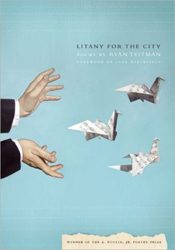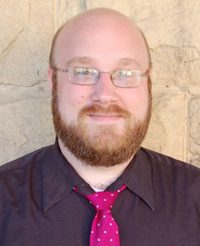
How well can we ever know the place we live in—the house, the neighborhood, the city, the moment? Is it possible to comprehend the way light, history, pianos, hawks, desire, trains, cruelty, red, Ben Franklin, faith, and baseball intersect in each fleeting second to create a place and time so particular in details it will never be repeated? In his award winning debut collection, Litany for the City, Ryan Teitman attempts a delicate and ambitious mapping of the self, the city, and the infinite connections that define and defy where one ends and the other begins. Jane Hirshfield selected Litany for the City as the winner of the A. Poulin, Jr. Poetry Prize. In her foreword, Hirshfield writes, “This is Ryan Teitman’s sustenance: denying no part of what it is to live on this earth.” Teitman’s litany is an act of both praise and of acute awareness of the beauty in the cities around and inside us.
Teitman begins his book in a solid time and place, establishing authority and giving readers a touchstone for the imaginative and often surreal qualities of the poems to come. The first poem, “Philadelphia, 1976,” grounds us in the particular. We enter Philadelphia on a “still night,” join a crowd of baseball fans “shuffling / for the parking lot.” We stand on the Tacony-Palmyra Bridge staring at the moon and listen to a speaker who suggests:
Maybe the moon’s a cut fastball dropping
off the horizon. Maybe 216 strands of loose city lightstitch the sky together. Someone told me
that the moon was made of cork
and jars of railroad sparks and braided horsehair.
But what’s our city made of?and leather and old bar songs
This is the question that guides the rest of the book, the question that Teitman answers in carefully crafted poems layering imagery, language, and repetition that function almost like those anatomical transparencies from old encyclopedias where the first page showed a skeleton, then the next page layered the muscles, followed by the organs, the veins, and skin. Teitman’s mapping of the physical city, its history, and the individual lives of its inhabitants and visitors is a complex emotional matrix of these transparencies. He writes, “Give me an almanac / listing all the old places / my father flew his kite.” We see the depth of the connections and there comes a point where they blend together—inner and outer stitched in a vocabulary of joining that Teitman creates with each poem. For example, in “Hard Light Through Hemlock,” we see images of pianos—“My father’s hands / at the piano pushed / against the muscles / of the keys” and “We returned to find / an old upright slumped / and half-buried by snow / like a fat doe shot / and forgotten.” A few poems later, in “Dear Doctor Franklin,” the image returns as an echo, a simile:
All my life I’ve tried to learn
what digs into our bones,
what uncouples voice
from desire and sets it
out to pasture like the old
piano left in the alley,
now filled with apple skins
and cat shit and wet copies
of the Daily News.
This repetition and layering is part of the litany that moves through not only individual poems, but the book as a whole. Everything returns—music, light, the moon, museums, trains, fire, newspapers, statues, bells—always at a new angle, sometimes literal, sometimes figurative, sometimes in the past, sometimes inside us. Teitman uses the form of the litany to both reinforce these connections and to accumulate imagery and emotion as he tries to answer that question: “But what’s our city made of?” In “Cathedrals,” he ends with a section of anaphora in short lines:
There’s a cathedral
built from the leg bones
of draft horses and saints.
A cathedral of birds
scaffolding the sky.
A cathedral of bodies
opening to each other
on beds smooth as altars.
A cathedral of hands
unbuttoning the skin
of every prayer
within reach.
Teitman maps the way only a poet can map, sketching in then blurring out the borders between inner and outer with each line. It is the poetic act of noticing that finds cathedrals everywhere. And language, repetition, is what holds it all together.

By the time we reach the final section of the book, “Metropolitan Suite,” it is clear that Teitman has moved beyond a particular city and a particular night. The poems are short untitled paragraphs tangled with imagery. This form literalizes the impossibility of clearly marking borders, almost as if that mapmaker has made countless maps of the city and all of them are true and all of them lead to and depend upon each other, and, most significantly, we need each one to discover where we are and where we are going. We might find ourselves anywhere—outside the Tube, in the elevator of the Empire State Building, eating lunch in Jaffa, or at a cocktail party where “each cube of ice has a hummingbird heart frozen in its center.” We might end up in “cold: the city that stills us all, with its slow-moving trains and its arctic-brilliant lights.” We come to understand that no matter where we are, we are in it: “City of anvils. City of rotten figs. City whose ground shakes like a bedsheet on the laundry line. City of heartflies. City like a doe’s tail snagged by thistle….”
This book has a heart that goes beyond the strength of its crafting or imagery. It reminds us of what only poetry can do. Hirshfield writes, “its heart is in the litany: in the persevering faith that words under pressure can charge and change language to something more than itself.” Read this book to renew that faith in words and in the abiding truth that there is nothing under the sky unworthy of our whole attention and fervent praise.




